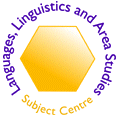
|
|
Excel at Academic EnglishReview Author: David Oakey, University of Hull Authors: Department of Languages, Anglia Polytechnic University, Cambridge, UK Distributors: Department of Languages, Anglia Polytechnic University, Cambridge, CB1 1PT, UK. Tel: +44 (0)1223 363447, Email: [email protected], WWW: www.anglia.ac.uk/efl System requirements: PC 486 SX, Windows 3.1, '95, '98,
8Mb RAM, 4Mb free hard-disk space, 4 speed CD-ROM drive, 256 colours
with "small fonts" selected, SoundBlaster compatible
sound card. A microphone is needed to make full use of the speaking
exercises. This CD-ROM loads without incident, and the user is swiftly brought to the first menu page, from which there is a choice of an introduction, skills units, and self-tests. The introduction provides a helpful guide to using the buttons and navigating through the exercises. The skills units are divided into the four main skills, and there are several practice tests. It gradually becomes clear that the International English Language Testing System (IELTS) exam has been the model for many of the exercises in each unit. The reading unit is split into two sections: one focuses on skills for using texts, such as identifying relevant information, while the other practises extracting information from texts, i.e. summarising and note-taking. Exercises in the first section deal with texts at the paragraph level, while the other section contains longer texts which the user scrolls down. The speaking section follows the IELTS interview format with question topics moving from the personal to the distant, and from real situations to hypotheses. The user can record his or her own answers and compare them with the models, and two full length model interviews are included towards the end. The listening unit contains some impressive content; familiar "fill-in-the-gaps" and "complete-the- table" exercises have transferred well to the CD-ROM’s click-and-drag format. The designers have taken advantage of the medium to vary the old "labelling-the-map-while-listening-to-someone- giving-directions" exercise by allowing the user to click-and-drag the starting point to get a new set of directions to a different destination. The quality of the recording and the speakers is of a much higher standard than on some IELTS preparation tapes on the market, i.e. two sleepy EFL teachers sitting in an echoing staffroom bordering a noisy corridor. A slight technical hitch in this section is that the playback stops if the user clicks and holds the text label over the intended release point. In addition, the "news reports" are read too slowly to sound natural, and the newsreader announces that the England cricket team has lost a "one day Test." To lose a Test Match in two days may be regarded as a misfortune, but to lose a match in one seems like carelessness! The writing section is also split into two parts, again mirroring the IELTS format, featuring discussion essays and data description. There are many useful exercises in this section. One drawback pedagogically is that the unit teaches an "introduction-body-conclusion" essay structure in that order. Students first plan the whole essay, and then write their introduction, then the main body, and finally the conclusion. However, the fact that an introduction comes as the first paragraph of an essay doesn’t necessarily mean that it is the first paragraph to be written. This formulaic structural approach to essay writing may be fine for English language qualification formats such as IELTS, but has little to do with the academic writing process. Students writing coursework at university follow a much more recursive learning-oriented path to the finished product. Students in university exams often go into the exam hall with a fair idea of the areas of their subject they are likely to be asked to write on, hence a lot of their planning has already been done during their exam revision. These last points lead to the main criticism of this CD-ROM. According to the back cover, it is first aimed at students who want to improve their English skills (no mention of "academic" here), then at students who need exam practice, and finally at students "who are studying or intending to study at an English speaking college or university." I would be loath to recommend "Excel at Academic English" to any students in this last group who are already studying at an English speaking college or university. The texts come mostly from journalism rather than academic sources. There are no exercises on using outside sources in writing, synthesising information from more than one outside source, bibliographic conventions, judging writers’ attitudes expressed through choice of reporting verbs, and so on. This CD-ROM is a very useful resource for students wishing to prepare for exams such as IELTS, but this to me does not provide sufficient justification for its title. David Oakey October 2000 |
 |
 |